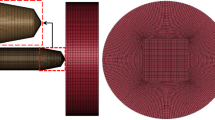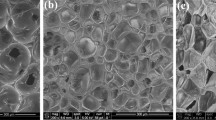Abstract
The mechanical behavior of elastomeric foam, in particular, Ethylene Propylene Diene Methyle (EPDM) and crushable foams, in particular, Expanded Poly-Propylene (EPP) and Poly Urthane Rigid (PUR), under low-velocity impact are studied experimentally and numerically. At first, these foams were loaded under quasi-static loading in compression. In order to study the dependence of their behavior on strain rate, the loadings were performed in two rates, 3 mm/min and 100 mm/min. The low-velocity impact tests were applied using a drop hammer testing machine. The drop heights of projectile in all tests were 0.5 and 1 m. The thickness effect of specimens on absorption of energy and parameters such as, contact force and displacement of specimens are discussed. Then, the dynamic factors of force and energy for three types of foam are investigated. Since, EPP showed an insensitive property to the thickness of specimen in the impact tests, it is possible to define dynamic factors for different thickness of this type of foam. Finally, all test results are compared with numerical results through implementation of ABAQUS finite element package. Good agreements between numerical results and experimental data show the capability of numerical modeling to fulfill the experimental investigation.
Similar content being viewed by others
References
Yang L.M, Shim V.P.W., A visco-hyperelastic constitutive description of elastomeric foam, Int. J. Impact Eng., 2004, 30, 1099–1110
Avalle’ M., Belingardi G., Montanini R., Characterization of polymeric structural foams under compressive impact loading by means of energy absorption diagram, Int. J. Impact Eng., 2001, 25, 455–472
Gibson L.J., Ashby M.F., Cellular Solids: structures and properties, 2nd ed., Pergamon press, Oxford, 1988
Jedari Salami S., Sadighi M., Sadough Vanini S.A., A Comparative Study of Mechanical Behavior of Elastomeric Foam FPDM and Elastic Plastic Foam EPP, 16th Annual (International) Conference of Mechanical Engineering, Kerman, Iran, 2008
Jedari Salami S., Sadough Vanini S.A.,, Sadighi M., A Theoretical and Experimental of Mechanical Behavior of Elastic Plastic Foams Under Static Loading, Na-tional Conference of Manufacturing and Production, Iran, 2007
Schwarts-Givli H., Frostig Y., High-order behavior of sandwich panels with a bilinear transversely flexible core, Composite Struct., 2001, 53, 87–106
Liu Z., G. Scanlon M., Modelling indentation of bread crumb by finite element analysis, Biosystems Eng., 2003, 85(4), 477–484
Du Bios P.A., Koesters M., Material behavior of polymers under impact loadings, Int. J. Impact Eng., 2006, 32, 725–740
Feng Z.Q., Peyraut F., He Q.C., Finite deformations of ogden’s materials under impact loading, Int. J. Nonlinear Mech., 2006, 41, 575–585
Feng Z.Q., Vallee C., Fortune D., The 3e’ hyperelastic model applied to the modeling of 3D impact problems, Finite element in analysis and design, 2006
Dawson M.A., Modeling the dynamic response of lowdensity reticulated elastomeric foam impregnated with Newtonian and non-Newtonian fluids, PhD thesis, Massachusetts Institute Technology, Cambridge, The unites states, 2008
Ko Y.H., Investigation of elastomeric pad attenuation of hand-transmitted vibration, Master thesis, University Sains, Malaysia, 2008
Shim V.P.W., Tu Z.H., Lim C.T., Two-dimensional response of crushable polyurethane foam to low velocity impact, Int. J. Impact Eng., 2000, 24, 703–731
Rizov V.L., Low velocity localized impact study of cellular foams, J. Materials & Design, 2007, 28, 2632–2640
Moreu Y.M., Impact compression polystyrene foam pyramids, Int. J. Impact Eng., 2003, 653–676
Rizov V.L., Elastic-plastic response of structural foams subjected to localized static loads, J. Materials & Design, 2006, 947–954
Rizov V.L., Local crushing of HCP100 structural foam due to low-velocity impact, J. Marine Structures, 2008, 47–58
ASTM D5308-92, Compression force deflection Test-Specified for flexible cellular foams for automotive and similar Energy Absorption Applications
ASTM D1621/94, Standard test method for compressive properties of rigid cellular plastics
Jedari Salami S., Sadough Vanini S.A., Sadighi M., Numerical and experimental study of mechanical behaviour for elastomeric EPDM foam and structural EPP foam under quasi static and impact loadings, KMCM 2008, Canada
Abaqus analysis user’s manual, Elastomeric foam behavior, ABAQUS ver. 6.5
Abaqus analysis user’s manual, Crushable foam plasticity model, ABAQUS ver. 6.5
Sadighi M., Pouriayevali H., Quasi-static and lowvelocity impact response of fully backed or simply supported sandwich beams, Journal of Sandwich Structures and Materials, 2008, 10,6, 499–524
Author information
Authors and Affiliations
Corresponding author
About this article
Cite this article
Sadighi, M., Salami, S.J. An investigation on low-velocity impact response of elastomeric & crushable foams. cent.eur.j.eng 2, 627–637 (2012). https://doi.org/10.2478/s13531-012-0026-0
Received:
Accepted:
Published:
Issue Date:
DOI: https://doi.org/10.2478/s13531-012-0026-0




